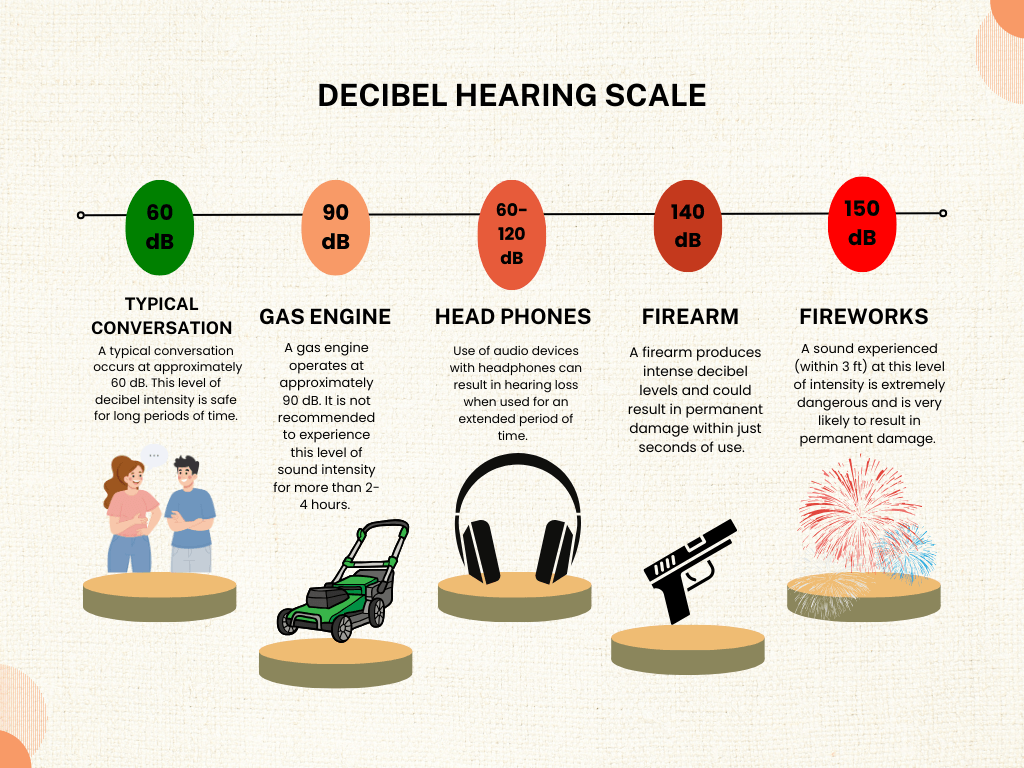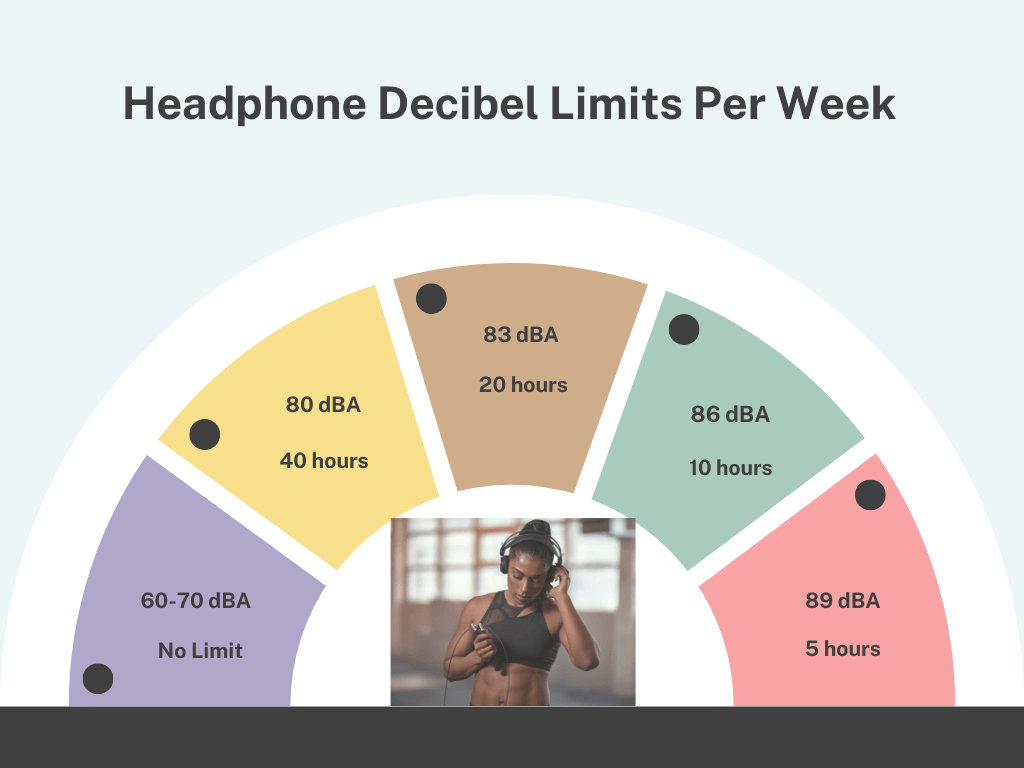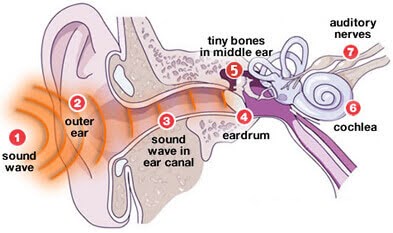What causes damage to the inner ear?
Noise induced hearing loss occurs due to damage to the inner ear structures and hair cells. This damage can either be due to a one-time, intense exposure (e.g. standing in close proximity to firework explosions), or due to an exposure to loud noises over a period of time (e.g. listening to music with headphones).The extent of NIHL depends on how the loss was initially caused. Loud sounds of decibels higher than that of 85 dB can gradually result in damage to the inner ear hair cells and structures (chronic NIHL), while noises of 120 dB and higher can result in traumatic injuries to the cochlea, tympanic membrane, or ossicles resulting in permanent damage (acoustic trauma).
Standing within 3 ft of a firework explosion exposes one to approximately 150 dB. At this level of sound intensity, there is a high likelihood that one would experience permanent damage to the inner ear. One might easily conclude that exposure to a loud sound would likely result in some hearing loss. However, what is not so easily acknowledged is the fact that sounds of lower intensity can also cause hearing loss when they are experienced over a longer duration. It is important to remember that both intensity of sound, and duration of exposure, are contributing factors to NIHL.
Take a look at the scale below for a better understanding of the types of sounds that can cause NIHL.
 (American Speech-Language-Hearing Association, 2020)
(American Speech-Language-Hearing Association, 2020)
DOWNS Tip: It’s important to realize you could be causing damage through everyday routines, such as headphone use, and not just at risk for a one time event.
Risk Factors
NIHL is not limited to age, gender, or race.
Everyday contributing environmental risk factors can be as unintentional as individuals partaking in or working in loud concert venues (over an extended period), in industries such as agriculture i.e., husbandry and construction i.e., machinery, (Cleveland Clinic, 2024), or simply driving in an automobile with amped up speaker systems at max levels. Those examples, however, are generalizations, as NIHL risk factors can also be attributed to “health factors, familial predispositions, medications, injuries to the ear and or exposure to organic liquid chemicals, such as toluene.”
In addition to that, pre-existing factors such as genetics, illnesses, damage that goes unnoticed without treatment can also increase the likelihood that an individual will suffer some degree of hearing loss or permanent damage (How Does Noise Damage Your Hearing?, 2020).
Another risk factor that can increase NIHL is distance to a sound, for example: how close an individual is to a sound source and the amount of time they are exposed to the sound. The louder the sound, the shorter the amount of time it takes to cause hearing loss.
According to Healthcanada.ca (2024) ways to reduce risk factors and now if your headphones are too loud:
- the volume level of your device is above 60% of maximum volume
- someone sitting or standing near you can hear what you're listening to
- you receive a warning from an app used to check the volume level
- Many smartphones have built in volume monitors that you can enable to give you warnings if you go above safe listening levels.
A Down’s group tip: The best course of action is to avoid loud noises, if possible, even for short periods of time, because there is no way to know your sensitivity to loud noises without causing damage.
Consequences
Tinnitus (ear ringing) - Tinnitus occupies your ears with ringing or buzzing sounds that are incurable, but manageable with an Audiologist. More than 50 million people are affected by this in the USA.
Sleep Issues/ irritability - When one experiences hearing loss, it affects sleep both with the absence of noise and or the addition of ringing from tinnitus. Reduction of auditory input affects sleep negatively affecting the sleep-wake cycle resulting in less REM sleep and less SWS (slow wave) Sleep.
Heart Issues - Noise exposure resulting in hearing loss has been linked to multiple heart ailments or conditions such as hypertension, arteriosclerosis (thickening of arterial walls), and ischemic or chronic heart disease. The link between these two issues is theorized to go through the autonomic nervous system and the endocrine system via stress responses. These stress responses elevate biological risk factors for cardiovascular issues.
Stomach issues - The stress that is caused on the body due to hearing loss can balloon into issues in the stomach. This can range from mild stomach issues to more intense issues such as Irritable Bowel Syndrome (IBS). It is not uncommon for people with NIH to complain of some form of stomach issue. This can cause indigestion, diarrhea, upset stomach, constipation, or abdominal cramps.
Mental health issues - Mental health issues accompany NIHL through difficult changes, feeling left out of events and conversations, lack of sleep, tinnitus ringing, increased difficulties at work, possible negative effect on love life, and additional obstacles to handle everyday life.
Financial burden - Untreated hearing loss can decrease income annually by up to $30,000. Untreated HL shows higher rate of unemployment (15.6% vs 7.8%)
Cognitive health issues - Losing your hearing can lead to losing brain cells that enable language cognition. One literally forgets what words sound like. The longer one goes without addressing and getting help for hearing loss, the harder it is to return to any semblance of normality when using assistive hearing devices. The brain experiences sensory issues during hearing loss and this causes stress. Imagine it when you go outside in the middle of the night, and you get scared because it is so quiet it makes you nervous. The absence of sound is stressful on the brain. Those who experience hearing loss and don’t get help are at greater risk of developing dementia.
Workplace obstacles - Greater obstacles experienced in employment transition and career development (promotions less likely). Adults working with hearing loss make on average 25% less than hearing counterparts. Many people fear asking for accommodations. Accommodation is also unavailable in many jobs.
Communication difficulties - Difficulties communicating with others and eventually lead to avoiding social situations. Areas with loud background noise prove to be more difficult. Those with hearing loss also tend to speak louder than others which can be unpleasant to family and friends. Hearing aids or implants can help with this.
DOWNS Tip: We know these are some scary outcomes. If you can relate to any of the above please seek professional medical advice or reach out to your employer for proper accommodations respectively.
How to prevent NIHL during exercise and beyond?
Limiting Exposure Time - Be mindful of the time spent listening to audio during long gym sessions or in any noise filled environments. Taking breaks will help minimize the risk of exposure to noise levels that can negatively impact your hearing. Quick bursts of loud noise can also contribute to NIHL.
DOWNS Tip: Turn your volume down before listening to any audio to ensure you're at a safe level when pressing play.
 (World Health Organization, 2019)
(World Health Organization, 2019)
Volume Control - Volume levels should be at a safe level when using devices you can control such as headphones. The World Health Organization suggests the 60/60 rule which encourages you to not listen through your headphones at any higher than 60% volume for more than 60 minutes.
DOWNS TIP: If your gym neighbor can hear Beyonce coming out of your head phones, you're probably at too high of a volume.
Use of Hearing Protection - Using earplugs or earmuffs in environments with loud noise levels or noise levels for a prolonged duration. Examples could include concerts/events, recreational activities, construction/power tool use. If you are in a company environment, advocate for apps or machines to monitor dB levels.
DOWNS TIP: Many smartphones allow you to set a headphone safety setting where you can set a maximum volume level.
Preventative Check ups - Establishing a routine hearing screening can also help detect early signs of NIHL.
Education and Awareness - Increased awareness programs out to the general public through various outlets (schools, doctors) to educate about hearing protection and noise levels in people's daily lives.
Here at DOWN’S we focus on every aspect of health, and we noticed that auditory health is one that doesn't get enough attention until it’s too late. We want our members to have the best information regarding their health when using our facilities, but also when you go back home at the end of your visit.
Whether you are putting your headphones on to listen to your workout playlist, getting ready for an upcoming concert, or heading off to work around loud machinery, we want you to think about taking care of your hearing.
If you find you have to increase the volume on the TV because it sounds muffled, have a hard time hearing a friend when out for lunch, or have distracting ringing in your ears, please plan a visit to an audiologist to get your ears checked for NIHL.
- The DOWN’S Family
 [Figure of human ear illustrating how hearing works ]. (n.d.)
[Figure of human ear illustrating how hearing works ]. (n.d.)
 (American Speech-Language-Hearing Association, 2020)
(American Speech-Language-Hearing Association, 2020)
 (World Health Organization, 2019)
(World Health Organization, 2019)